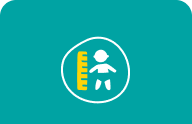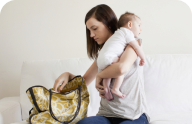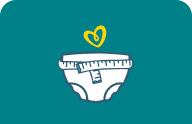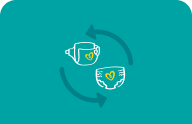Tips for Flying with Your Baby: From Pre-flight to Diaper Changes

Considering air travel with your little one? Flying with a baby can come with challenges. For some babies, flying is a breeze—they can sleep through the entire trip! For others, the process is a bit tougher. And then comes the diaper changes in tight spaces! But with a little preparation, it’s totally doable! Here are some tips on how to change a diaper on a plane and other key travel tips to make your journey easier.
Tips to Help You Prepare Before Flying
Flying with your baby can be challenging, but it doesn't have to be stressful! With a bit of preparation and a positive attitude, it can even be enjoyable.
Many babies adapt well to changes in their eating and sleeping schedules, and with any luck, they might be quite content during the trip. Read on for tips to help make flying with your little one as stress-free as possible.
Making Flight Reservations and Other Preparations
Choose an evening flight. Flying is way easier with a sleeping baby, so consider booking an evening flight to increase the chances of your little one nodding off. If a daytime flight is your only option, you might try delaying your baby’s usual nap until after takeoff.
Allow plenty of time between connecting flights. When you’re traveling with your baby, give yourself as much extra time as possible to get from one terminal or concourse to the next to make your connecting flight.
Select seats in advance. If you can, choose your seats early so you’ll have more options. The bulkhead area (behind the wall that often separates cabins) has the most room. For safety reasons, you won’t be able to choose an exit row. If available, pick a seat by the window. An aisle seat won’t be as safe for your baby, especially during meal service.
If you can, purchase a seat for your baby. The Federal Aviation Administration (FAA) doesn’t require you to purchase a seat for your child if they're younger than 2 years old and you plan to keep them on your lap, but buying a separate seat is recommended. Having your baby in your lap during turbulence can be dangerous. Many babies might be more content and relaxed if they’re in their own seats. If you do purchase a seat for your baby, you’ll need to bring your own FAA-approved infant car seat.
Have your baby’s passport ready for international travel. When it comes to air travel with a baby, your little one will need a valid passport to fly internationally, just like you. You’ll need to apply for your baby’s passport in person at a passport office. Check-in with your local office or the U. S. Department of State website to find out what types of documentation you’ll need to provide, such as a birth certificate. You'll also need a photo of your baby taken within the past six months. The photo should be of them alone with a white background. You could either have the photo taken by laying your baby on a white blanket or towel or by having them sit in a car seat covered by a white sheet. You might consider having the photo taken by a professional photographer who specializes in passport photos.
Get any prescriptions filled beforehand. If your baby needs certain medications, it’s a good idea to get them filled in advance just in case you can’t get them at your destination.
Getting Ready for the Flight
Bring your FAA-approved infant car seat. If you’ve purchased an airplane seat for your baby, the FAA requires that you use an approved child restraint system (CRS). The good thing is many infant car seats are approved for use on aircraft, which means you may be able to use the infant seat you’re already using in your vehicle. Make sure the infant car seat you bring has a clearly visible label with the following: “This restraint is certified for use in motor vehicles and aircraft.” Here are the requirements for using a CRS on an aircraft:
Place your CRS in the rear-facing position if your child weighs under 20 pounds.
Place your CRS in the forward-facing position if your child weighs between 20 and 40 pounds.
Another option is to use an FAA-approved child harness device (CARES) for your child who is between 22 and 44 pounds.
This device is approved for use on aircraft exclusively and will have a label with either of the following: “FAA Approved in Accordance with 14 CFR 21. 8(d), Approved for Aircraft Use Only” or “FAA Approved in Accordance with 14 CFR 21.305(d), And 21.50 6-9-1980, Approved for Aircraft Use Only.”
For more information on this, visit the FAA’s page on flying with children.
Pack thoughtfully. Consider what you might need at the airport, during the flight, and once you land. You’ll need enough of everything, but don’t pack too much since you’ll be carrying it. Make sure you have all the diapering supplies you’ll need, including extra diapers. Other essentials can include baby wipes, a changing pad, a blanket, your little one’s favorite soft toy, baby food, pacifiers, a change of clothes, and plastic bags for dirty diapers or soiled clothing. You may decide to pack all of this in your own carry-on bag or take it in a separate diaper bag. Find out how many bags the airline allows as carry-on, as you may need to pay extra if you go over the carry-on limit. Check out our section below on How to Change a Diaper on a Plane [Link to: <H2>How to Change a Diaper on a Plane<H2>], including what diapering essentials to bring with you.
Bring expressed breast milk (if needed) or formula. Although the TSA’s rules generally don’t allow liquids over 3.4 ounces in a carry-on, parents with babies are exempt from this. Simply pack your expressed breast milk, liquid formula, or powdered formula with the water separate for mixing later. Notify the TSA agents at the security check that you have these items. They will most likely ask you to remove them from your bag for screening separately. Learn more about the best way to store breast milk for travel.
Pack books or toys for older babies and young children. Having a few favorite toys or books on hand can help keep your child occupied during the flight and during waiting periods at the airport.
Pack earplugs for your baby. An aircraft cabin can get quite noisy, especially during takeoff. Pack small earplugs, cotton balls, or noise-canceling headphones so that you can protect your baby’s ears from the loud noise. It might also help your little one sleep more comfortably, too.
Dress your child in layers. Since an airplane cabin’s temperature can vary greatly, it’s a good idea to dress your child in layers. Go for layers that are easy to put on and remove, like elastic-waist pants, zippered sweaters, and snap-crotch jumpsuits.
Check in online. Checking in is so much easier these days with self-check-in kiosks at the airport, as well as the option to check in online through the airline’s website or smartphone app. Since you’re traveling with your baby, why not check in ahead of time, before you even leave for the airport? This is also a great way to confirm that the flight is still running and hasn’t been rescheduled or canceled.
Navigating the Airport with Your Baby
Use a child carrier. Strapping your baby into a baby carrier or sling will allow you to have your hands free as you navigate through the airport. Keep in mind that you may need to remove your child from the carrier before going through airport security and carry them through the metal detector.
Use a stroller. If you plan to take your stroller with you on the trip, you may decide to use it when navigating the airport. You may prefer not to check the stroller at the luggage drop-off. Instead, use it until you board at the gate, where a member of the crew can check it. Once you land, you’ll get the stroller back.
Take advantage of pre-boarding perks for families. Gate agents usually offer families with small children the opportunity to board the airplane first. This way you don't have to fight through the crowds to get to your seats, making it easier to get everyone settled. Exit last for the same reason unless you have to make a connection.
Ask for help if you need to make a connection. Make sure to let a flight attendant know if you need to make a connecting flight. A member of the crew may be able to help you by ordering a transportation cart to take you to the next gate.
Change your baby’s diaper before boarding. If there’s time, change your baby’s diaper before boarding the aircraft. Many airports have specifically designed family restrooms that you can utilize for this purpose.

Diaper Bag Essentials

What are your diaper bag must-haves? From essentials to just-in-case extras, every parent packs a little differently. Take our fun quiz to see how your diaper bag stacks up against other Pampers Parents.
Instant Results
Enjoyment Guaranteed
Personal Insights
Flying with Your Baby
Watch the in-flight safety video. When the plane starts taxiing, you may be preoccupied with getting your baby comfy, as well as yourself, but it’s important to pay attention to the in-flight safety video, especially when traveling with your little one. For example, when it comes to using the oxygen masks that drop from overhead when air pressure is lost in the cabin, you will likely be instructed to position the mask on yourself first before placing it onto your baby.
Wash and sanitize your hands. Whenever air travel with a baby is on the agenda, be sure to wash your hands frequently or use hand sanitizer to reduce your baby’s exposure to germs. Keeping your hands clean is a key step in ensuring a healthy and enjoyable journey for both you and your little one.
Be prepared for your baby’s ears to hurt. The changes in pressure that happen in an airplane’s cabin during takeoff and landing can make your baby’s ears uncomfortable. Nursing your baby, giving them a bottle, or having them suck on a pacifier can help equalize the pressure in their middle ear.
Plan your baby’s sleeping options. Buckling your baby into their CRS is the safest option for napping and sleeping, but some airlines may be able to provide a more comfortable way for your infant or baby to get some shut-eye:
Bassinet. If you’ve chosen seats behind the bulkhead, there’s a good chance the airline may have a bassinet you could use. The bassinet attaches to the bulkhead wall and can hold a baby under 6 months old and/or 20 pounds. Ask your airline in advance whether this is an option.
Sleeper seat. On international airlines, you may be able to book three seats in a row that have the option to interlock to form a big sleeper that can fit a parent and a child. Check with your airline in advance for more information on the availability of this option.
Inflatable seat extension. If your airline allows, you may be able to bring an inflatable seat extension to use for your baby when it’s time to sleep or nap. This type of product is new on the market, and not all airlines may allow it. Keep in mind your child must have their own seat to use this add-on product. Check with your airline in advance for more information on whether this is allowed.
Keep in mind that during takeoff and landing, your baby cannot be using any of these sleep devices. They must be in your lap or in a CRS. Moreover, even on an airplane, you still need to follow safe sleep practices. Make sure that your baby is placed on their back for sleeping and that they're on a firm, flat surface with no soft bedding.
Don't hesitate to ask for help. The flight attendant or the person sitting next to you may be more than willing to help, especially if you are traveling alone with your baby. Many other people have been or will be in similar situations and don't mind lending a hand. Accept offers from the crew or other travelers to help with loading carry-ons into the overhead compartment, for example.
Try to remain calm and focused. Don’t take your own fears or frustrations out on your child. If your child has a meltdown mid-flight, don't worry about what other people on the airplane think or whether they’re staring. Keep calm and do your best. As long as you stay cool, your baby will be more likely to do the same.
How to Change a Diaper on a Plane
Changing a diaper on a plane may seem daunting, but with the right tips and preparation, it can be manageable—even in a cramped cabin! So, how do you change a diaper on an airplane? We’ll give you some helpful tips below.
Finding Suitable Locations for Diaper Changes on a Plane
Ever wondered, “Do airplanes have changing tables?” The answer is yes—most airlines offer a travel-changing table located in the restrooms. However, these tables are small and often tucked above the toilet, so space will be limited.
Here’s what to do if you’re unsure where to go:
Ask the flight attendant. They can direct you to the restroom with a changing table or suggest the best option for your airline.
Scout before takeoff. Once seated, quickly ask the crew about the location of the airplane changing table to avoid any last-minute surprises.
If there’s no changing table. You’re not out of luck! Use your travel changing mat and find a flat(ish) space, such as the toilet seat, galley floor, or an empty row of seats (with permission, of course). Always be respectful of other passengers when doing this.
How to Change a Diaper in a Confined Space
Changing a diaper in tight quarters is a skill of its own, but a little planning can save the day:
Plan ahead. Before boarding, ensure your baby is dressed in clothes that are easy to remove and make diaper changes more straightforward. Consider elastic-waist pants and snap-crotch onesies.
Pack strategically. Before heading to the restroom, grab only the essentials—one diaper and wipes—rather than lugging your entire diaper bag. You might also want to bring a change of clothes for your baby, just in case an unexpected mess happens.
Be organized. Lay everything out within reach before you begin to avoid fumbling around in the tiny space.
Use downtime wisely. If the bathroom feels claustrophobic during turbulence or busy times, take advantage of quieter intervals to handle diaper changes comfortably.
Keep your baby occupied. Use a small toy or distraction to keep your little one calm while you manage the diaper situation in the cramped restroom.
Clean up. After you’re done changing your little one’s diaper ensure you dispose of the diaper properly, wipe down any surfaces you were using, and wash your hands thoroughly.
If you want to know how to change a diaper in different scenarios, read our dedicated article which covers everything from trains and planes to automobiles.
Diapering Essentials to Bring on Board
When traveling with an infant or toddler, having the right diaper essentials can make all the difference. Here’s your must-have diaper-changing list for a smooth flight:
Diapers. If you’re wondering how often you should change your baby’s diaper, it’s likely they’ll need changing every 2 to 3 hours. It’s best to check their diaper every few hours to ensure it’s not too wet, and always change them after they’ve pooped. A diaper with a Wetness Indicator, like Pampers Swaddlers, is a great way to check if your baby is wet. Bring at least one diaper for every 2-3 hours of your trip, plus a few extras. Air travel delays happen, and it’s better to be over-prepared!
Wipes. Baby wipes are convenient for both diaper changes and wiping sticky hands and airplane tray tables. Try Pampers Sensitive Baby Wipes for your little one’s delicate skin.
Changing pad. Invest in a foldable travel-changing table pad. These are a lifesaver when you need to change a diaper without a proper surface.
Diaper disposal bags. Use these for easy and discreet disposal of dirty diapers—especially on a crowded flight.
Spare outfit. Always carry a backup outfit for your baby (and maybe one for you). Spills and diaper blowouts don’t take breaks just because you’re on an airplane. You can help prevent diaper blowouts by checking your baby’s diaper fits right and by using Pampers diapers that are designed to help prevent blowouts and leaks.
Small toy or snack. A comforting distraction can keep your baby entertained while you manage the diaper change efficiently.
By packing smart and staying calm, you can master how to change a diaper on an airplane without breaking a sweat!
The Bottom Line
When flying with your baby, focus on making them as comfortable as possible and remaining calm. With a little preparation, flying with your baby can go smoothly, and before you know it, you’ll be landing at your destination. Bon voyage!
Don’t forget to pack plenty of diapers and wipes for your trip. Did you know that for every Pampers product you buy, you could be earning rewards? Download the Pampers Rewards app, scan the items you purchase, and “Pampers Cash” to receive rewards and discounts.
How We Wrote This Article The information in this article is based on the expert advice found in trusted medical and government sources, such as the American Academy of Pediatrics and the American College of Obstetricians and Gynecologists. You can find a full list of sources used for this article below. The content on this page should not replace professional medical advice. Always consult medical professionals for full diagnosis and treatment.
Review this article:
Join a World of Support
through Pregnancy and Parenthood.
![toy]()
TRACK WITH TOOLS
![baby]()
LEARN WITH EXPERTS
![Gift]()
GET REWARDED

Where You Already Belong










